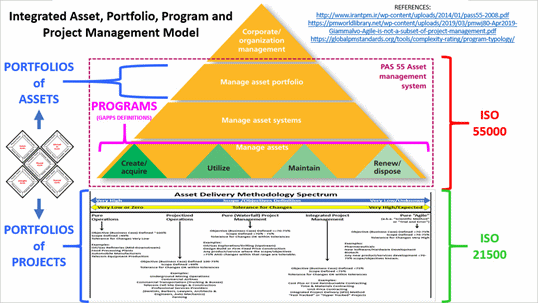Bringing It All Together …
- In Figure 2, we identified a method developed 65 years ago by Esso or Diamond Shamrock Oil, attested to the fact that it works, and is still in use today. So what do we have to do to expand this model and adapt it for use in other contexts and sectors? Why are we so unwilling to accept what we know for a fact actually works?
- Figure 13 shows a Proposed Fully Integrated Model.
 Figure 13: Proposed Fully Integrated Model [click to enlarge]
- We know that the Institute for Asset Management was founded in 2004, producing PAS 55 Parts 1[22] and Part 2[23] which evolved into ISO 55000. While the IAM was originally focused only on PHYSICAL assets, it is evolving into covering all five of the asset classes. To bring yourself up to speed on the Asset Management Model take 10 minutes to watch this video — youtube.com/watch?v=pLuMX_9WVFg.
- The Global Alliance for Project Performance Standards conducted an assessment and validation of research done initially by Prof. Sergio Pelligrinelli that identified four generic categories of "programs".[24] This covers all five of the asset categories.
Figure 4 shows us the five "Asset Delivery Options" that any organization can choose from to "create, acquire, update, expand, repair, maintain and eventually dispose of organizational assets". In Figure 2 we can see how important it is to match the availability of "organizational assets" (people, money, knowledge, physical and intangible resources) and matching those with the portfolio of projects? One of the reasons so many projects fail is that organizations take on too many projects without sufficient resources to support all those projects.
- We know from "lessons learned" from the oil patch that one of the reasons they rely so heavily on "Engineer, Procure, Construct and Commission" (EPCC) contracts is because they recognize they do not have the resources to dedicate to managing projects. Is this a "Lesson Learned" that can and should be adopted/adapted by other sectors?
- Figures 9 and 10 illustrate clearly that "Waterfall" and what is known by our IT colleagues as "Agile" or "agile" in all the combinations or permutations is not inconsistent with the Asset Life Span.
- So, to paraphrase from the 1984 Wendy's commercial asking "Where's the BEEF?"[25] Here we are, engaging in never ending debates about which is "better" "agile or waterfall" when apparently neither are working satisfactorily.
For 10+ years, "heretics" such as Glenn Butts, NASA, Bent Flyvbjerg, Oxford and Ed Merrow from IPA along with many others, have not only identified what the root cause problems are, but have proposed SOLUTIONS to them. Yet after 10 years, PMI, IPMA, AACE, APM/APMG et al still continue to ignore them. Why?
22. PAS 55-1 (2008) irantpm.ir/wp-content/uploads/2014/01/pass55-2008.pdf.
23. PAS 55-2- (2008) hadidavari.com/wp-content/uploads/2018/03/PAS-55-2-2008.pdf.
24. GAPPS (n.d.) globalpmstandards.org/wp-content/uploads/2014/12/GAPPS-Program-Typology.pdf.
25. Wendy's Commercial (1984) "Where's the Beef?" youtube.com/watch?v=EOyQfd7OqIY.
|



